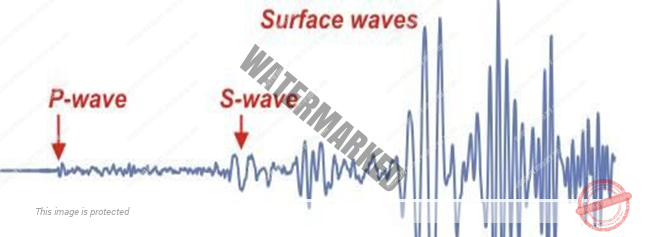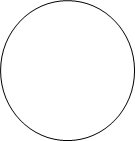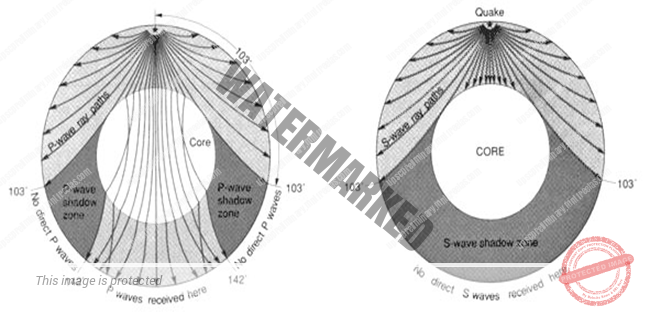- EARTHQUAKE
- MEASUREMENT OF AN EARTHQUAKE
- DISTRIBUTION OF EARTHQUAKES
- SEISMIC WAVES & BODY WAVES
- ANTIPODE
- CAUSES & IMPACT OF EARTHQUAKES
- SHADOW ZONE
UNIT 2 – EARTH – PART 3
Earthquake “Is a form of energy of Wave Motions transmitted through the surface layer of the earth in widening circles from a point of sudden energy release, the Focus”.
It is a natural event. Earthquake results from the sudden release of pressure which has slowly built up within the earth’s crust.
Energy is released in the form of shockwaves known as Seismic Waves. It is recorded by an instrument called “Seismograph or seismometer at the epicenter. Focus or Hypocenter is the location inside the earth where the earthquake originates. Epicenter is the point on the earth’s surface vertically above the focus of an earthquake.
There are two types of earthquakes in nature.
- TECTONIC – associated with faulting movement of rocks.
- VOLCANIC – associated with major volcanic eruptions.
On the basis of depth, tectonic earthquakes are categorized into 3 types.
- SHALLOW earthquakes – where the depth of focus is less than 70km.
- INTERMEDIATE earthquakes – where the depth of focus is 70 to 300km.
- DEEP EARTHQUAKES – where the depth of focus is 300 to 700km.
About 90% of earthquakes are within a focus less than 100km deep.
MEASUREMENT OF AN EARTHQUAKE
- INTENSITY SCALE: This scale was prepared by Italian scholar Giuseppe Mercalli in 1903. He measured earthquake on the basis of intensity & intensity reflects the impact of earthquake. The severity of earthquake shaking is assessed using a descriptive scale – the Modified Mercalli Intensity Scale. The range of intensity scale is from 1-12.
- MAGNITUDE SCALE: This scale was prepared by scholar named F. Richter in 1935.Earthquake size is a quantitative measure of the size of the earthquake at its source. The Richter Magnitude Scale measures the amount of seismic energy released by an earthquake. The magnitude is expressed in numbers from 0-10.
DISTRIBUTION OF EARTHQUAKES
- CIRCUM PACIFIC BELT: – This belt includes Western Sides of North and South Americas & Countries like Indonesia, Philippines, Japan Etc. This belt registers about 80% of quakes in the world. This belt registers all three types of earthquakes (shallow, intermediate & deep). The earthquake proneness is because of subduction boundaries.
- TRANS-EURASIAN MOUNTAIN BELT: – This belt extends from Mediterranean Sea through southwest Asia & Himalayas into the Southeast Asia where it meets circum pacific belt. This belt registers about 15% of world’s earthquakes and experiences only shallow and intermediate earthquakes. The earthquake proneness is because of convergent boundaries.
- The third zone of earthquake is associated with global system of mid oceanic ridges with an extension to include East African rift valley system. This belt registers only shallow earthquakes.
SEISMIC WAVES
Seismic waves are the waves of energy caused by the sudden breaking of rock within the earth or an explosion. They are the energy that travels through the earth and is recorded on seismographs.
What Is Seismology?
Seismology is the study of earthquakes and seismic waves that move through and around the earth. A seismologist is a scientist who studies earthquakes and seismic waves.
1). Body waves
2). Surface waves.
BODY WAVES: – Body waves are generated due to the release of energy at the focus and move in all directions travelling through the body of the earth. They are classified in two types
1.P or Primary waves are the fastest seismic waves (6 km/sec) are the first to arrive at the surface. They cause the matter to oscillate forward and backward, parallel to the motion of the seismic wave front. This exerts pressure on the material in the direction of the propagation. They pass through solid, liquid and gaseous materials.
2. S or Secondary waves are slower than the primary waves (3.5 km/sec. in the upper crust). They cause matter to oscillate side to side, perpendicular to the motion of the wave front. Hence, they create troughs and crests in the material through which they pass. They pass through only solid medium.
Surface Waves: Surface Waves are the waves that travel along the earth’s surface. They are slower than body waves. These waves are more destructive. They cause displacement of rocks, and hence, the collapse of structures occurs.
ANTIPODE
The antipode of any place on the Earth – the place that is diametrically opposite it, so a line drawn from the one to the other passes through the centre of the Earth and forms a true diameter. For example, the antipodes of New Zealand’s lower North Island lie in Spain.
FOR EXAMPLE: if A is epicenter; A¦ is anticenter. The term anticenter refers to antipode of epicenter of an earthquake.
SHADOW ZONE
Earthquake waves get recorded in seismographs located at far off locations. However, there exist some specific areas where the waves are not reported. Such a zone is called the ‘shadow zone’.
Shadow zone for p waves Shadow zone for s waves
Shadow zone for p waves: 103° to 142° on both sides.
Shadow zone of S-wave: entire zone beyond 103°.
The shadow zone of S-wave is much larger than that of the P-waves.



